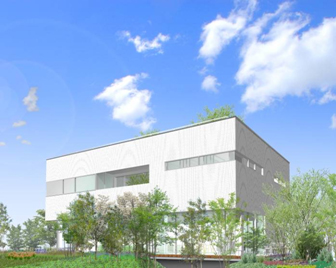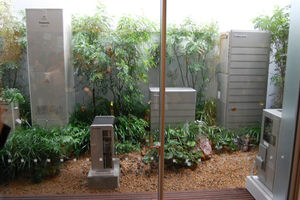No edit summary |
m (+cat) |
||
| (14 intermediate revisions by one other user not shown) | |||
| Line 1: | Line 1: | ||
[[File:Eco Idea House.jpg|right|thumb|336px|Panasonic's Eco Idea House<ref>http://www.greendiary.com/entry/panasonics-eco-idea-house-is-a-beacon-of-sustainable-living/</ref>]] | |||
The Panasonic Eco Idea House is a building on the edge of the Tokyo Bay in Japan that emphasizes green technology and sustainable living. Panasonic presented the Eco Idea House in 2009 as a proof of concept for modern sustainable living. The house was also positioned as a response to global warming and the depletion of natural resources. It features a wide variety of modern technologies that result in virtually zero carbon emissions.<ref>http://panasonic.co.jp/ecohouse/en/</ref> | The Panasonic Eco Idea House is a building on the edge of the Tokyo Bay in Japan that emphasizes green technology and sustainable living. Panasonic presented the Eco Idea House in 2009 as a proof of concept for modern sustainable living. The house was also positioned as a response to global warming and the depletion of natural resources. It features a wide variety of modern technologies that result in virtually zero carbon emissions.<ref>http://panasonic.co.jp/ecohouse/en/</ref> | ||
==History== | ==History== | ||
Panasonic’s Eco Idea House was unveiled in 2009. It currently stands as a part of the Panasonic Center in Tokyo. The building is open to the public on weekends | Panasonic’s Eco Idea House was unveiled in 2009. It currently stands as a part of the Panasonic Center in Tokyo. The building is open to the public on weekends. Admission is free. | ||
==Design== | ==Design== | ||
The Eco Idea House operates | The Eco Idea House operates with the motto “Create Energy, Store Energy, Manage Energy, Save Energy.” | ||
===Generators=== | |||
[[File:Eco idea house power.jpg|right|thumb|Fuel cells power the house and store reserve energy in lithium-ion batteries.<ref>http://dvice.com/archives/2009/10/a-tour-of-panas.php</ref>]] | |||
The Eco Idea House requires no outside energy to function, operating completely off the grid. To meet its limited electricity needs, the house employs roof-based solar panels and hydrogen fuel cells in the backyard. Excess electricity is stored in lithium-ion batteries.<ref>http://www.google.com/hostednews/afp/article/ALeqM5iQnngMNfy7i3HHhXY3lBfvPySqXA</ref> | |||
===Sensors=== | |||
Sensors in the home detect where residents are and manage power accordingly. Lights and appliances turn on and off as people enter and leave rooms in order to use as little electricity as possible.<ref>http://www.google.com/hostednews/afp/article/ALeqM5iQnngMNfy7i3HHhXY3lBfvPySqXA</ref> | |||
===Heating=== | |||
Temperatures of individual areas are controlled in order to avoid heating empty rooms. Air can also be blown directly on occupants, saving energy by heating or cooling only the people, rather than the whole room.<ref>http://panasonic.co.jp/ecohouse/en/Air/index.html</ref> Heaters and air conditioners supplement airflow with a pocket of air under the house that naturally stays warmer in the winter and cooler in the summer.<ref>http://dvice.com/archives/2009/10/a-tour-of-panas.php</ref> The house also has insulation with a vacuum layer to further prevent the escape of heat. In addition, the house's hot water pipes double as floor heating. | |||
===Water=== | |||
The combination washer/dryer in the Eco Idea House has a tilted drum, which requires less water to wash clothes. | |||
===Lighting=== | |||
Many windows and skylights allow sunlight to light the house in the day while LEDs illuminate it at night. Photosensors adjust the intensity of the LEDs based on the amount of sunlight.<ref>http://panasonic.co.jp/ecohouse/en/Light/index.html</ref> | |||
==Technologies== | ==Technologies== | ||
*[[fuel_cells|Hydrogen fuel cells]]<ref>http://dvice.com/archives/2009/10/a-tour-of-panas.php</ref> | |||
*[[Solar panels]]<ref>http://dvice.com/archives/2009/10/a-tour-of-panas.php</ref> | |||
*[[Use of Silicon Anodes in Lithium Ion Batteries|Lithium-ion batteries]]<ref>http://dvice.com/archives/2009/10/a-tour-of-panas.php</ref> | |||
*Vacuum [[House insulation|insulation]]<ref>http://dvice.com/archives/2009/10/a-tour-of-panas.php</ref> | |||
*[[LED lighting]]<ref>http://dvice.com/archives/2009/10/a-tour-of-panas.php</ref> | |||
*AC/DC hybrid wiring system<ref>http://dvice.com/archives/2009/10/a-tour-of-panas.php</ref> | |||
*Home energy management system<ref>http://dvice.com/archives/2009/10/a-tour-of-panas.php</ref> | |||
*Tilted-drum washer/dryers<ref>http://panasonic.co.jp/ecohouse/en/Water/index.html</ref> | |||
==References== | ==References== | ||
{{Reflist}} | {{Reflist}} | ||
[[Category:Japan]] | |||
Revision as of 22:55, 6 November 2015

The Panasonic Eco Idea House is a building on the edge of the Tokyo Bay in Japan that emphasizes green technology and sustainable living. Panasonic presented the Eco Idea House in 2009 as a proof of concept for modern sustainable living. The house was also positioned as a response to global warming and the depletion of natural resources. It features a wide variety of modern technologies that result in virtually zero carbon emissions.[2]
History
Panasonic’s Eco Idea House was unveiled in 2009. It currently stands as a part of the Panasonic Center in Tokyo. The building is open to the public on weekends. Admission is free.
Design
The Eco Idea House operates with the motto “Create Energy, Store Energy, Manage Energy, Save Energy.”
Generators

The Eco Idea House requires no outside energy to function, operating completely off the grid. To meet its limited electricity needs, the house employs roof-based solar panels and hydrogen fuel cells in the backyard. Excess electricity is stored in lithium-ion batteries.[4]
Sensors
Sensors in the home detect where residents are and manage power accordingly. Lights and appliances turn on and off as people enter and leave rooms in order to use as little electricity as possible.[5]
Heating
Temperatures of individual areas are controlled in order to avoid heating empty rooms. Air can also be blown directly on occupants, saving energy by heating or cooling only the people, rather than the whole room.[6] Heaters and air conditioners supplement airflow with a pocket of air under the house that naturally stays warmer in the winter and cooler in the summer.[7] The house also has insulation with a vacuum layer to further prevent the escape of heat. In addition, the house's hot water pipes double as floor heating.
Water
The combination washer/dryer in the Eco Idea House has a tilted drum, which requires less water to wash clothes.
Lighting
Many windows and skylights allow sunlight to light the house in the day while LEDs illuminate it at night. Photosensors adjust the intensity of the LEDs based on the amount of sunlight.[8]
Technologies
- Hydrogen fuel cells[9]
- Solar panels[10]
- Lithium-ion batteries[11]
- Vacuum insulation[12]
- LED lighting[13]
- AC/DC hybrid wiring system[14]
- Home energy management system[15]
- Tilted-drum washer/dryers[16]
References
- ↑ http://www.greendiary.com/entry/panasonics-eco-idea-house-is-a-beacon-of-sustainable-living/
- ↑ http://panasonic.co.jp/ecohouse/en/
- ↑ http://dvice.com/archives/2009/10/a-tour-of-panas.php
- ↑ http://www.google.com/hostednews/afp/article/ALeqM5iQnngMNfy7i3HHhXY3lBfvPySqXA
- ↑ http://www.google.com/hostednews/afp/article/ALeqM5iQnngMNfy7i3HHhXY3lBfvPySqXA
- ↑ http://panasonic.co.jp/ecohouse/en/Air/index.html
- ↑ http://dvice.com/archives/2009/10/a-tour-of-panas.php
- ↑ http://panasonic.co.jp/ecohouse/en/Light/index.html
- ↑ http://dvice.com/archives/2009/10/a-tour-of-panas.php
- ↑ http://dvice.com/archives/2009/10/a-tour-of-panas.php
- ↑ http://dvice.com/archives/2009/10/a-tour-of-panas.php
- ↑ http://dvice.com/archives/2009/10/a-tour-of-panas.php
- ↑ http://dvice.com/archives/2009/10/a-tour-of-panas.php
- ↑ http://dvice.com/archives/2009/10/a-tour-of-panas.php
- ↑ http://dvice.com/archives/2009/10/a-tour-of-panas.php
- ↑ http://panasonic.co.jp/ecohouse/en/Water/index.html